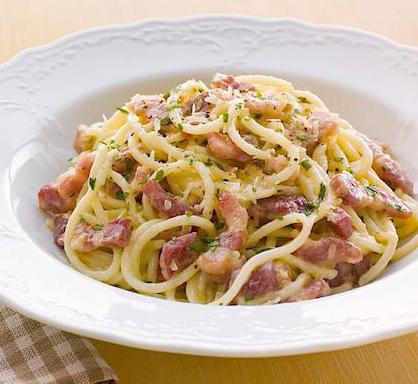
Easy Bacon Macaroni Recipe. Description of preparation: Delicate creamy sauce gives the pasta a mild taste, and bacon makes it a hearty dish. Instead of Rigatoni, you can use any other pasta of your choice. Ingredients. Serve baked pasta
Doctors believe that meat does not go well with pasta. Unpleasant fermentation can occur in the stomach and, as a result, bloating can occur. But sometimes it is simply impossible to deny yourself the pleasure when there is fragrant bacon with pasta on the plate. Moreover, both of these products can be prepared in different ways.
Hastily
In the case when the time allotted for cooking is extremely limited, you have to go against some rules. Even though bacon and pasta are not ideal ingredients, people often use both in the same dish. This happens for two reasons. First, the result of such a neighborhood has excellent taste characteristics. Secondly, bacon with pasta is very easy to prepare. To do this, you may need the simplest products.
Duck eggs, dove and parrot were very much appreciated. The overlay gets a really special flavor if you add honey and pepper. When the omelet is cooked on one side, turn it on a flat plate, spread it with honey and season with pepper. Boil tuna and egg fillets separately. Drain the fish, rub it and beat it with celery, thyme, oregano, salt, pepper and egg yolks that are already boiled. With this sauce, stuff the egg white and season the butter before serving. It's Elixa - eggs, garum, oil, pepper, laser eggs - with grub sauce, oil, pure or derived from lycemia, pepper and silk. Cheese and honey croquettes. Whisk the condensed milk, honey and salt into a bowl, adding some wheat flour to the dough. Make small portions and fry them in lard. When the pancakes are gilded in all parts, they will be degummed and served hot, softened with other honey. Pasta with cheese mixed with fruits. Serve with honey and toppings. Stuffed dates and nuts were used for sweet preparations, true specialties of ancient Rome. Typical are the dried figs available in Rome every season. Sugar: They did not have cane sugar and used honey, and also changed to grape sugar, juicy and sweet concentrate and beetroot syrup. Granite is a sweet spicy spoon whose origin usually consists of Arab dominance in Sicily. Of course, there was no granite, but there were different fruits, from cherries, cottage cheese, pears and even to pineapple, which the Romans knew widely when they demonstrated There was no special service for ice, so merchants climbed with mules on the snowy mountains and brought it to Rome, where they were buried in metal containers. Destroying it wasn't a problem. Therefore, a variety of fruit granite was part of the Roman desserts. Peaches their entry into Europe was attributed to Alexander the Great in expeditions against the Persians, according to other Greeks, would have introduced them from Egypt Apricots from Karelian Armenia for sweets and soups Pomegranate, fresh fruits It is also used in painting and in Roman bas-reliefs: Corbezzolo, like fruit, more for sauces or cakes, dried as fruit or meat. Almonds, introduced to Sicily by the Phoenicians from Greece, so that the Romans called them "Greek walnut". The chestnut, widely used, was boiled, roasted or dried, or boiled with dill or in a puree or soup.
- Boil the eggs, cut them open and fortify them with wine and garum sauce.
- Prepare a mixture with eggs, milk and salt.
- Pour some oil into the pan when the mixture heats up.
- The dates are then roasted in honey.
- Cake cake.
- The hall is all and warm in honey cooked.
- Apples, fresh fruits.
- Pears, fresh fruits.
- Quince apples are boiled with honey and also mixed with almonds or hazelnuts.
- Fresh figs, but mostly dried, with honey and almonds, or flavored roast.
- Pinels were used as fruits, in sweets, and also for roasting.
For 300 grams you need: an onion, 40 grams of cheese, a clove of garlic, salt, 200 grams of bacon and ground pepper.
Making bacon with pasta is easy.
- The first step is to boil the pasta.
- While they are boiling, you need to finely chop the onion, bacon and garlic.
- Fry the prepared products for 3 minutes in a well-heated pan.
- Add one and a half cups of water and wait until it evaporates.
- Add the pasta, stir and immediately remove the pan from the heat.
- Before serving, the finished dish should be sprinkled with grated cheese directly in a portioned plate.
Everything is prepared very quickly. In addition, the recipe is so simple that even someone who is not at all versed in cooking can handle it.
The snow was very expensive because of this work, however, who could taste the exquisite creams in the snow and ice cream, milk and eggs. Milk: coagulated with hay juice ejected by young ruminants not yet weaned; The rhombus resulted in hurried baskets still in use today. Conus writes that Azin's milk was used a lot for the little one, because it is light and easily digestible. For growth problems, goat's or sheep's milk was recommended to children, and tired teenagers mixed a little red wine. FROM goat milk and donkey seasoned with watercress were cooked good drinks. Cow's milk, on the other hand, was less valued and consumed by the poorest class. Butter was not produced as it was difficult to preserve. Mulsum, spiced wine with honey. Vinegar: As Cato writes, both the farmer and the warrior on the march, prepared before they left the bottle, filled it with water and then added an abundance of vinegar. Vinegar was refreshing, disinfectant, and a pleasant drink, even if it was accommodating. Often in the contracts with the soldiers there was a mandatory vinegar, and there was never wine. The lemon was there, but it wasn't used for cooking, just for healing. Children and teenagers did not miss, at least once a day, a bowl of mares. . It seems that the vine existed in Tuscany before the appearance of man, and the Etruscan colonizers of the Tuscan depths, and probably the first inhabitants of the Chianti region, were tamed by wild animals, and wine honored the dead, along with the dance and the sound of flutes.
Great addition
It turns out very tasty if you cook pasta with bacon in a creamy sauce. The aroma of such a dish will not leave anyone indifferent. To work, you need only 500 grams of spaghetti, spices, half a liter heavy cream, 150 grams of parmesan cheese, salt, basil and 200 grams of raw smoked bacon.

In particular, there were widespread religious practices in the aristocratic class in honor of "Fufluns", the god of wine. These rites were secret and strictly reserved for initiates, thanks to the inspiration of the drink, the Possession of God. The wines in Rome were very low alcohol, so they were easily acidified. Luxury wines were usually prepared and subjected to a very long aging and, to be drunk, mixed with at least 50% water. Wines imported from Greece, the African coasts, and Asia Minor were mainly treated with aromatics: resins, herbal extracts, honey, fragrant woods, herbal essences, myrrh, absent odors, and roses.
The whole cooking process can be divided into 3 parts:
- First you need to boil the pasta al dente, that is, until half cooked. To do this, after boiling water, it will take no more than 7 minutes. Strain the spaghetti and drizzle lightly with oil to keep it from sticking together.
- Now you can get on with the sauce. To do this, the first step is to fry the bacon literally to a crisp. Add salt and cream, bring everything to a boil, then cook for a couple of minutes. Then you need to throw cheese into the pan and wait until it melts. Only after that you can add basil and spices.
- In conclusion, it remains only to combine both components and serve the dish to the table. This can also be done in different ways: pour pasta with cooked sauce or preheat both products together for 2-3 minutes.
Here everyone chooses exactly the option that suits him best.
Since the Greeks brought the vine to the Mediterranean, the Romans passed it on to the rest of Europe, although their wines had different characteristics and, above all, were less sweet. They brought the vine to Provence, north of France, Germany, the Rhine and the Moselle.
In the first two centuries of the Christian era, Italy became the largest importer of wine from the Empire, shipping it from Greece, Spain and Gaul. But Spain began to become a major producer of wine and produce wine as wheat production was taken away and starved for the entire Empire.
For this reason, Domitiano issued a decree forbidding the planting of new vines in Italy, in order to reduce the vineyards in the provinces to no more than half. He also refused to grow small vineyards in Italian urban areas. However, it appears that the Domitian Decree, born as a political measure, was never enforced. In 280, Emperor Probo revoked Domitiano's decree, but gave a strong impetus to the development of agriculture.
Sleight of hand
There is another rather interesting one with bacon. True, this method requires special dexterity and skill. And first you need to pick up the main ingredients.
For 300 grams of spaghetti we take half a glass of white wine, a clove of garlic, a tablespoon of butter, 200 grams of bacon, 4 egg yolks, salt, 4 sprigs of parsley, pepper and olive oil.
Pasta baked with cheese sauce has a delicious aroma and taste
In Italy, Campania was the most fortunate land for Faleno Capua and Falerno, recommended for 10 years of aging and with two types: dry and sweet. From abroad came, among other things, the wines of Cio, Sicione, Cyprus. The wine was as sweet as the grape pass.
In the provinces of Tarragona, Andalusia and the city of Cadiz, the wine was of excellent quality and arrived in Rome in about a week and was used by the Romans. Or it was added to brine wine and rosin. The addition of barley flour and cheese produced an aphrodisiac potion, at least when you read about the cup found in Ischia: Anyone who drinks this cup will immediately catch Aphrodite's desire for a beautiful crown. It was the Roman soldiers, among the best lovers of wine, to export vines to northern Europe, at first freely following the precise rules dictated by the emperors, planting them in famous and well-known areas such as Bordeaux, Burgundy, Loire and Champagne.
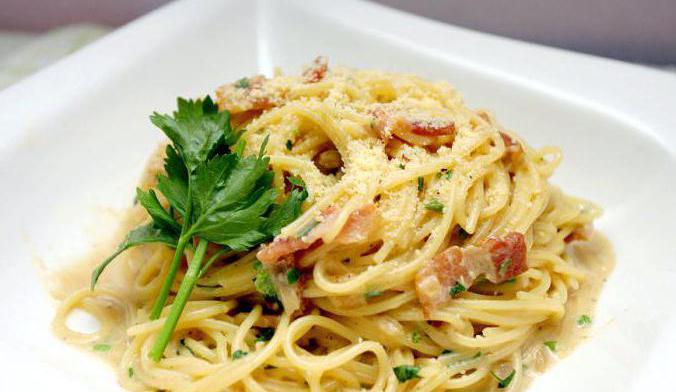
You need to prepare such a dish according to the following method:
- Boil pasta until half cooked.
- At this time, cut the bacon into cubes and fry it in oil with garlic.
- Grate the parmesan, and then add the wine, chopped herbs and melted butter to it. Grind the products to a mushy state.
- Enter beaten yolks, add pepper and salt.
- Before serving, quickly combine both cooked semi-finished products. To make it convenient to mix the products, the plate must first be warmed up.
This dish should be eaten immediately after preparation. Cooling down, it will lose its effect and taste.
Therefore, the famous French wines must be born in the vineyards cultivated by the Romans, and often the Romanians are transplanted into the Celtic world of today's France. Dol containers containing sparkling wine were kept at a low temperature with cold water to prevent fermentation. If the resulting wine was cloudy, they proceeded to figure out the use of white egg white or fresh goat's milk.
Macaroni with cheese and bacon
Wine intended for immediate consumption was placed in oysters made from goat or pig skin; The one destined for export was poured into large terracotta containers, the famous pittroi, which could hold hundreds of liters, and then into double barrel ampoules called serials, with the tip sticking out of the floor. Amphoras have been marked with the name of the trader or manufacturer to ensure quality. The poor farmer was pleased light vinegar obtained with fragments of marjoram.
Pasta with bacon is one of my husband's favorite dishes taken from the bachelor period of his life. Bacon is, in general, such a product that should be in the refrigerator when I leave home. It is very useful for men - even in his scrambled eggs, even where. Pre-sliced bacon is especially handy because you don't have to cut it!
For one serving you need 120 gr. some pasta, 1 large onion and at least 50 gr. bacon. Plus some oil for frying, if the bacon is not greasy and small, salt in the pasta is to taste; and plenty of water to boil the pasta.
Wines that are of little value were not spilled, but the precious ones were poured into amphoras. The amphora had a stamped label on which was the place of origin of the wine, the name of the producer and the name of the consul in office. Between 20 and 10 a.k. But wine was not drunk only in houses, because there was a thermopolis where you could buy ready meals. It was a small room with a counter containing large terracotta amphorae capable of holding food. There are many remains in the excavations of Pompeii and Herculaneum. Beer was known, but not very revered.
The sun is already setting behind the hills in the west. The cat is looking for a comfortable spot under the rosemary bush in front of the kitchen door. Our small group of ten cooking enthusiasts from the United States, Austria and Germany are looking forward to the kitchen with its large open fireplace. Waiting for Maestra Ornella, who will start us in the secrets of the Umbrian cuisine. Suddenly there was a noise of a car, gravel crunched, creaked. Everyone gets hugs, a hearty "Cao!" And kiss on both cheeks. Two pheasants, of course, with feathers. Flour, milk, sugar and at the very bottom are two giant pumpkins so big that even our "strong men" have trouble pulling them out.
We give a large amount of water to boil in a saucepan, salt it, cook the pasta in boiling water until it becomes soft. Well, or as much as it says on the package. Then we drain the water.
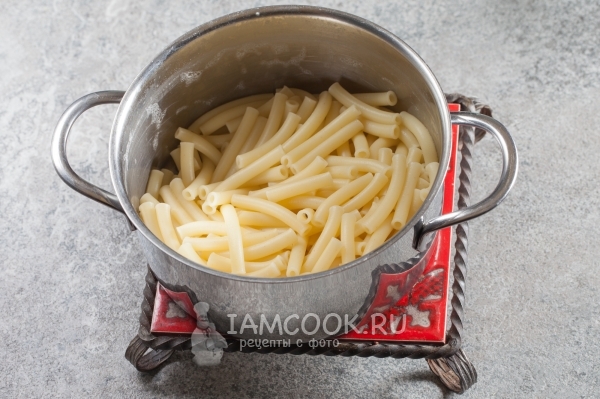
We clean the onion from the husk and cut it somehow.
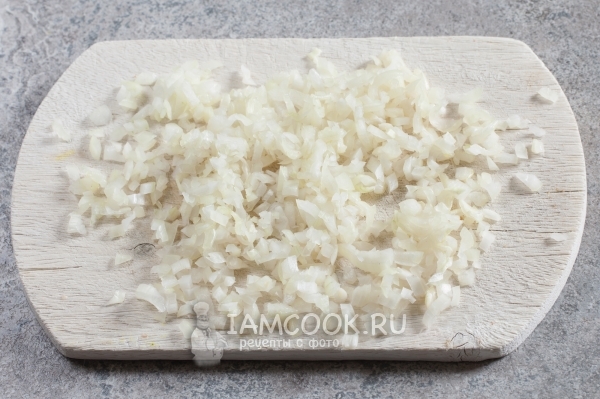
Now we start: again a short presentation; Ornella is trying to pronounce our foreign names. But then she announces that of course she will think of nicknames for everyone that she can keep in mind. Subsequently, a wine waiter is appointed, one of the most important tasks of the week. Program for the first lesson: Mushroom risotto with black truffles, a plate of Norcia ham, wild boar salami, lardo di colonnata and pecorino. For a dessert of rich peaches filled with pine kernels and almonds. Everyone is surprised: “And we will eat all this?” Ornella replies with false indignation: "Ma-percha sie-qui?" Why are you here? For cooking food. “And who cooks should eat too, right?” Let's work!
If bacon big chunks and fatty, then we start frying it in a pan. If the bacon is small and not greasy, then first fry the onion in some oil. The main thing is not to burn. And it will burn - this will give the dish a special spicy bitterness!
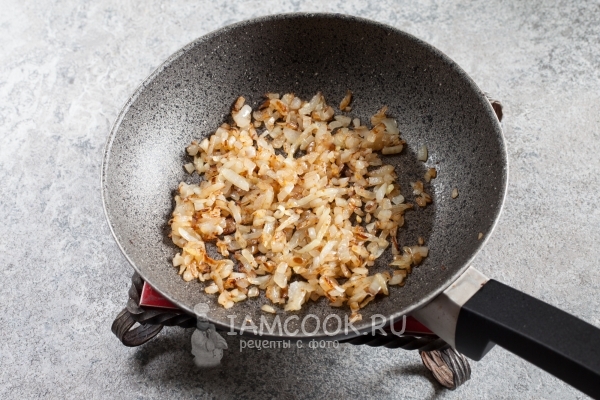
When the onion has browned, add the bacon. If he wasn't there from the start. Fry the onion along with the bacon.
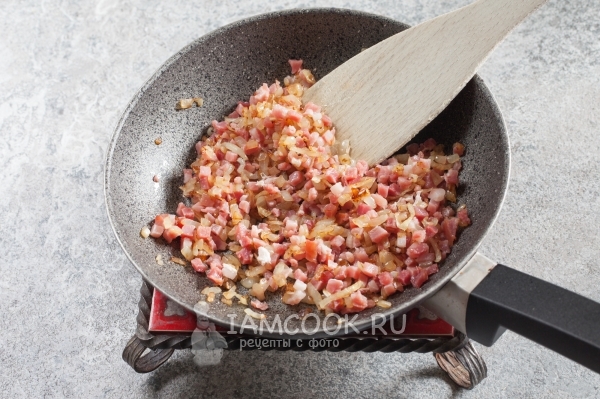
Mix onion with bacon ready-made pasta from which water has been drained. Bacon pasta is ready.
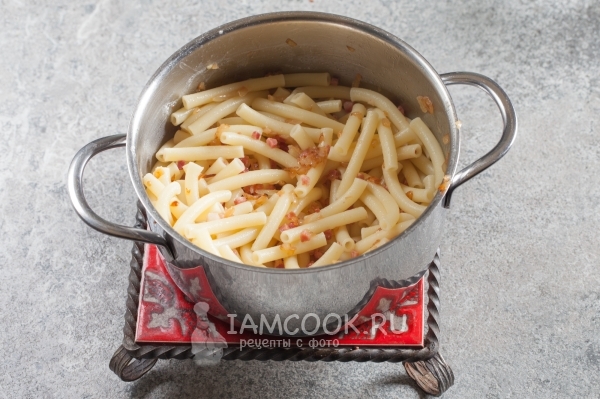
You can eat even from a pot, even from a frying pan.
Why dirty a plate?